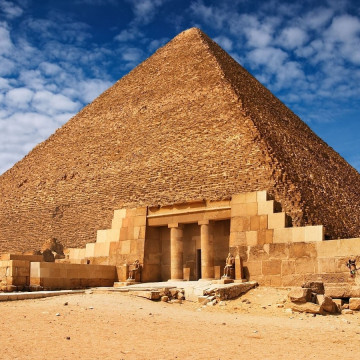Ancient Egyptian - architectural style definition
Ancient Egyptian architectural style was specific to Egypt between 3150 BC and 395 AD and was uniquely characteristic of the country and its culture. Egyptian architecture was inspired by the landscape and climatic conditions of the region and by the ever-growing needs of the society.
One of the most important elements of Egyptian architecture was the use of stone, which was available in abundance in Egypt. Stone was used to build temples, palaces, pyramids and other structures. Egyptian architects were able to take advantage of its properties, such as weather resistance and resistance to wear and tear, which meant that many buildings have survived to this day.
Another important element of Egyptian architecture was the use of columns and arches, which were often used in the construction of temples and palaces. Columns were used to support ceilings and roofs, while arches were used as a decorative feature or as a structural element.
Egyptian architecture was also characterised by the use of many decorative elements, such as paintings and sculptures. Paintings were often placed on the walls and ceilings of buildings, and sculptures were placed outside or inside buildings.
The architectural style of ancient Egypt is one of the most recognisable and influential styles in the history of architecture. It is characterised by monumental, permanent structures that reflect the deep religious and cultural beliefs of the ancient Egyptians. Here is some information about the style, its precursors and key buildings.
Precursors of the architectural style in ancient Egypt
Pre-Dynastic Period: This period (c. 5500-3100 BC) included many earlier experiments in construction, such as mastabas - stepped pyramidal tombs that were earlier prototypes of the later pyramids.
The most popular buildings of ancient Egypt
Pyramids of Giza: The Pyramids of Giza, including the Great Pyramid of Cheops, are the most famous structures of ancient Egypt. They are the monumental tombs of the pharaohs, erected as the ruler's resting places after death. In addition to the Great Pyramid, the Pyramid of Chephren and the Pyramid of Mykerinos are also worth mentioning.
Valley of the Kings: the Valley of the Kings in Luxor is the burial place of pharaohs and elite members of society. It contains many impressive tombs in the rocky terrain, including those of Takmosis III, Ramses II and Tutankhamun.
The Pyramid of Cheops at Giza: The Pyramid of Cheops is the largest and oldest of Egypt's pyramids. It was built around 2500 BC for the pharaoh Cheops and is one of the seven wonders of the ancient world. The pyramid is 146 metres high and is made of more than 2 million stones weighing 2.5 tonnes each.
Karnak Temple: The Temple of Karnak is a huge temple complex in Luxor, which was the religious and cultural centre of ancient Egypt. The temple consists of many buildings, including the largest Christian church in the world, which was built for Pharaoh Amenhotep III.
The Royal Palace of Thebes: The Royal Palace of Thebes is one of the most important monuments of ancient Egypt. It was built around 1400 BC for Pharaoh Amenhotep III and was the seat of state authority and the place where state treasures were kept. The palace consists of a number of buildings, including the Royal Audience, where important ceremonies and state meetings were held.
Luxor Temple: the Luxor Temple, also known as the Temple of the Million Years, was another important place of worship in Egypt. It was built by many dynasties of pharaohs, and its most distinctive feature is the Avenue of the Sphinxes leading to the main entrance.
Temple of Hatshepsut: The Temple of Hatshepsut in Deir el-Bahari is the impressive tomb temple of Queen Hatshepsut, who was one of the few female Pharaohs in power in Egyptian history. Her temple was built in a colonial style, with many terraces and colonnades.
These are just a few examples of the most important buildings of ancient Egypt. The architectural style of this period is full of fascinating details and has a profound significance for the history of art and architecture.















